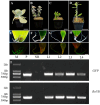A Rapid Method for Obtaining the Transgenic Roots of Crassulaceae Plants
- PMID: 39519943
- PMCID: PMC11548563
- DOI: 10.3390/plants13213024
A Rapid Method for Obtaining the Transgenic Roots of Crassulaceae Plants
Abstract
Crassulaceae plants are valued for their horticultural, ecological, and economic significance, but their genetic improvement is hindered by the absence of efficient and stable genetic transformation methods. Therefore, the development of a tailored genetic transformation method is crucial for enhancing the progress of the genetic improvement of Crassulaceae plants. The results indicate that, in the transformation experiments conducted on Kalanchoe tetraphylla, the K599 strain exhibited the highest transformation efficiency (76.67%), while C58C1 was least efficient (21.43%). An acetosyringone concentration of 100 μM was optimal for the hairy root transformation, and the immersion method yielded the highest efficiency. Additionally, the Silwet L-77 concentration significantly influenced the transformation efficiency, with 0.05% leading to a decrease. Upon four Crassulaceae species, notable differences were observed, with K. tetraphylla exhibiting the highest efficiency of 100%, and Sedum alfredii displaying the lowest efficiency of 5%. The RUBY reporter gene offers a more distinct advantage over GFP in observing the transformation effects. This study developed a simple, feasible, and cost-effective method for obtaining transgenic roots from leaves of Crassulaceae. The methodology provides technical support for the genetic improvement and gene function research of Crassulaceae plants.
Keywords: Agrobacterium-mediated transformation; Crassulaceae; GFP reporter; RUBY reporter; transformation system.
Conflict of interest statement
The authors declare no conflicts of interest.
Figures





Similar articles
-
One-step generation of composite soybean plants with transgenic roots by Agrobacterium rhizogenes-mediated transformation.BMC Plant Biol. 2020 May 12;20(1):208. doi: 10.1186/s12870-020-02421-4. BMC Plant Biol. 2020. PMID: 32397958 Free PMC article.
-
An efficient genetic transformation system mediated by Rhizobium rhizogenes in fruit trees based on the transgenic hairy root to shoot conversion.Plant Biotechnol J. 2024 Aug;22(8):2093-2103. doi: 10.1111/pbi.14328. Epub 2024 Mar 16. Plant Biotechnol J. 2024. PMID: 38491985 Free PMC article.
-
Highly efficient Agrobacterium rhizogenes-mediated hairy root transformation in citrus seeds and its application in gene functional analysis.Front Plant Sci. 2023 Oct 31;14:1293374. doi: 10.3389/fpls.2023.1293374. eCollection 2023. Front Plant Sci. 2023. PMID: 38023879 Free PMC article.
-
A Review of the Popular Uses, Anatomical, Chemical, and Biological Aspects of Kalanchoe (Crassulaceae): A Genus of Plants Known as "Miracle Leaf".Molecules. 2023 Jul 21;28(14):5574. doi: 10.3390/molecules28145574. Molecules. 2023. PMID: 37513446 Free PMC article. Review.
-
Transformation of medicinal plants using Agrobacterium tumefaciens.Postepy Hig Med Dosw (Online). 2016 Dec 20;70(0):1220-1228. Postepy Hig Med Dosw (Online). 2016. PMID: 28026825 Review.
References
-
- Liu X.Y., Zhang D.Q., Zhang J.Q. Plastomic data shed new light on the phylogeny, biogeography, and character evolution of the family Crassulaceae. J. Syst. Evol. 2023;61:990–1003. doi: 10.1111/jse.13003. - DOI
-
- Winter K., Smith J.A.C. Crassulacean Acid Metabolism: Biochemistry, Ecophysiology and Evolution. Springer; Berlin/Heidelberg, Germany: 2011.
-
- Reinert F., Blankenship R.E. Evolutionary aspects of crassulacean acid metabolism. Oecologia Aust. 2010;14:359–368. doi: 10.4257/oeco.2010.1402.02. - DOI
-
- Souza L., Oliveira J., Fernandes A.D.S., Macedo A.F., Araujo-Lima C.F., Felzenszwalb I. UHPLC-MS metabolomic profile and in silico pharmacokinetic approach of Kalanchoe daigremontiana Raym.-Hamet & H. Perrier aqueous extracts. J. Pharm. Biomed. Anal. 2024;238:115827. doi: 10.1016/j.jpba.2023.115827. - DOI - PubMed
Grants and funding
LinkOut - more resources
Full Text Sources

